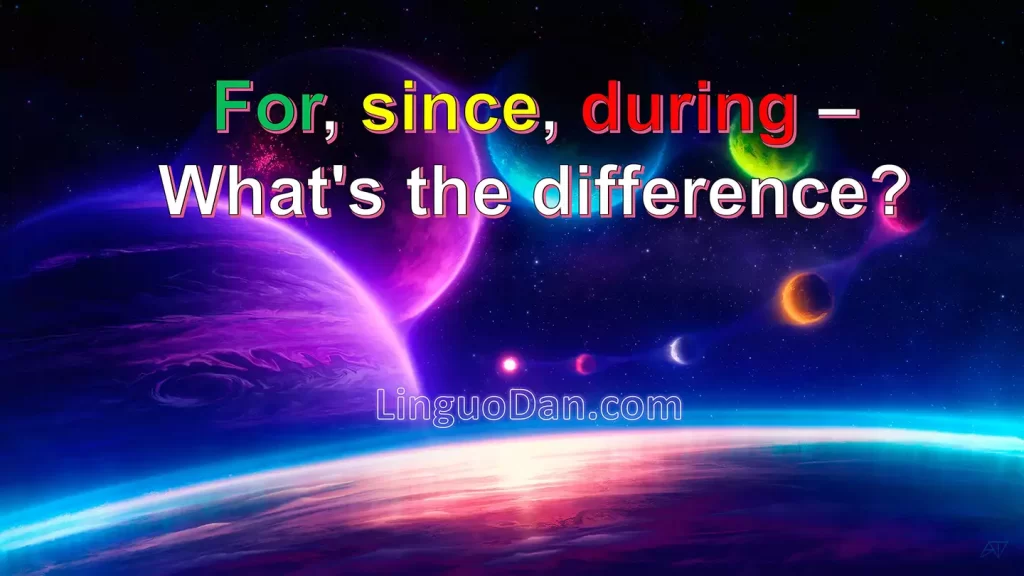For, since, during – What’s the difference?

Using “for,” “since,” and “during” in English
In English, there are several words that are commonly used to express duration, time relationships, and specific time frames. Among these words, the prepositions “for,” “since,” and “during” play important roles in conveying temporal information accurately. Understanding their usage and differences is crucial for learners of English. In this article, we will explore how to use “for,” “since,” and “during” effectively in various contexts.
- “For“: The word “for” is used to indicate the duration or length of time an action or event has taken place. It is followed by a specific length of time, such as minutes, hours, days, weeks, months, or years. Consider the following examples:
- I have been studying English for three years.
- They lived in London for two months.
- She worked at the company for a decade.
In these examples, “for” is used to express how long an action or event has been happening. It establishes a connection between the starting point of the action and the present or past time frame. Remember to use “for” with a numerical value to denote a specific length of time.
- “Since“: The word “since” is used to indicate the starting point of an action, event, or a specific point in time. It is followed by a particular day, month, year, or a time phrase. Let’s look at some examples:
- I have been learning English since 2010.
- They have been friends since kindergarten.
- She has been a vegetarian since last year.
In these sentences, “since” is used to establish the starting point of the action or event. It connects the beginning of the action with the present or past time frame. “Since” is typically followed by a specific point in time, rather than a length of time.
- “During“: The word “during” is used to indicate a particular time or period within which an action or event occurs. It emphasizes the temporal context in which something happens. Consider the following examples:
- I read a book during my vacation.
- They had a party during the weekend.
- She practiced yoga during her lunch break.
In these sentences, “during” highlights the timeframe or period in which the action or event takes place. It provides information about when the action occurred within a broader temporal context.
It is important to note that “during” does not convey the duration of an action or event but focuses on the specific time frame in which it occurs.
Differences between “for,” “since,” and “during”
Differences between “for,” “since,” and “during”: While “for,” “since,” and “during” all relate to time, they have distinct usages:
- “For” is used to indicate the duration or length of time an action or event has been happening.
- “Since” is used to mark the starting point of an action or event.
- “During” is used to specify the time frame or period in which an action or event occurs.
Understanding these differences will enable you to accurately express temporal relationships and durations in English.
The “since“, “for“,“during” rule in Perfect tenses
In English, the Perfect tenses (such as Present Perfect and Past Perfect) also require the appropriate use of “since,” “for,” and “during” to convey duration, starting points, and specific time frames. Let’s explore how they are used in Perfect tenses:
- Present Perfect: In the Present Perfect tense, “since” and “for” are used to indicate the duration of an action or event that started in the past and continues into the present. Take a look at these examples:
- She has lived in New York since 2010.
- We have known each other for ten years.
In these sentences, “since” marks the starting point of the action in the past, indicating that the action began in 2010 and continues up to the present moment. On the other hand, “for” is used to express the duration of the action, specifying that they have known each other for a period of ten years.
Additionally, “during” can be used in the Present Perfect tense to specify a particular time frame in which the action or event occurred:
- I have traveled to many countries during my lifetime.
Here, “during” emphasizes that the action of traveling to various countries took place within the span of the speaker’s lifetime.
- Past Perfect: In the Past Perfect tense, “since” and “for” are used similarly to the Present Perfect tense but with reference to a past time. Here are a couple of examples:
- I had known her since we attended the same school.
- He had worked for the company for five years before he quit.
In these sentences, “since” marks the starting point of the action in the past, while “for” expresses the duration of the action leading up to a specific point in the past.
Furthermore, “during” can also be used in the Past Perfect tense to specify a particular time frame:
- They had traveled extensively during their vacation in Europe.
In this example, “during” highlights the specific time frame of their vacation in Europe when the extensive traveling occurred.
Remember that the correct usage of “since,” “for,” and “during” in Perfect tenses is essential for accurately conveying the relationship between duration, starting points, and specific time frames.
In conclusion, the correct usage of “for,” “since,” and “during” is essential for effectively communicating time-related information in English. “For” expresses duration, “since” denotes the starting point, and “during” emphasizes the temporal context. By mastering the usage of these words, you will enhance your ability to express duration, starting points, and specific time frames accurately and fluently.